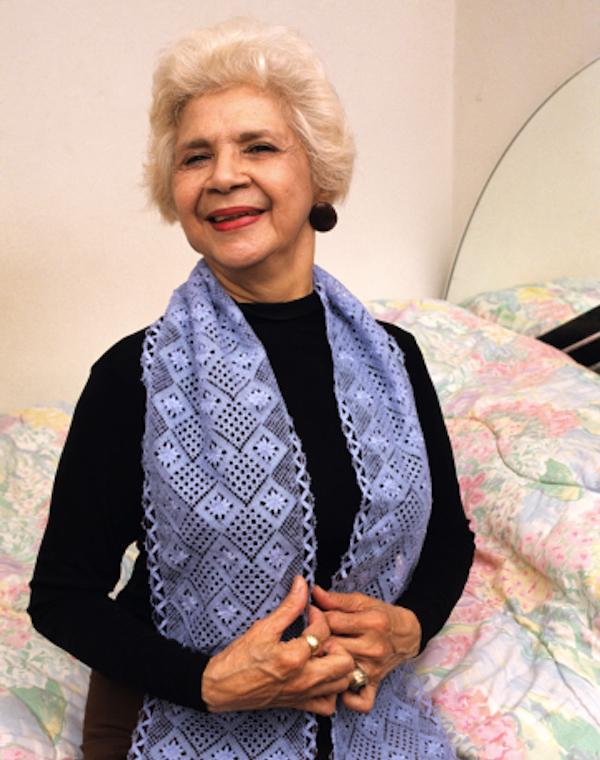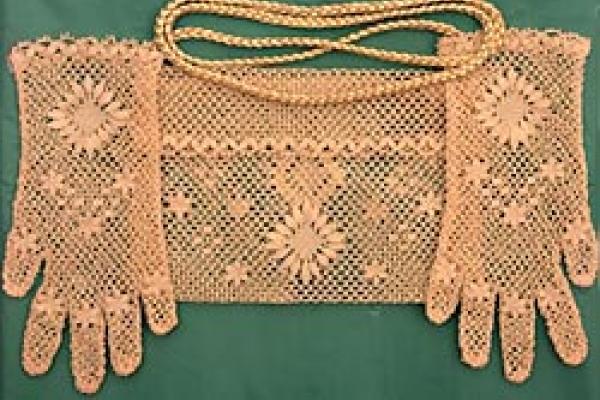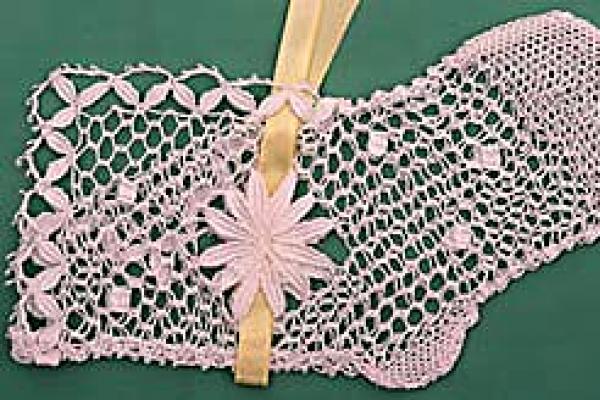Rosa Elena Egipciaco

Photo courtesy of the artist
Bio
Mundillo, the art of weaving delicate lace using wooden bobbins wrapped with thread probably originated in 16th-century Italy and then spread across Europe. The tradition came to Puerto Rico with the Spanish and reached a high state of refinement in towns such as Moca and Isabella.
Rosa Elena Egipciaco was born in Moca into a family steeped in lace-making, as her mother and grandmother were noted makers of lace. She recalls starting to learn mundillo when she was three or four years old. After graduating from the University of Rio Piedras, she continued to practice mundillo and co-founded the Cultural Center of Moca. In 1986, Egipciaco moved to New York and dedicated herself to teaching lace-making through a variety of programs ranging from workshops for the International Ladies Garment Workers Union to serving as a master in the New York State Council on the Arts Folk Arts Apprenticeship Program.
She currently teaches at Boricua College in Brooklyn and demonstrates the art of lace-making at institutions such as the American Museum of Natural History, El Museo del Barrio, and New York University. Egipciaco continues to create new designs for collars, blouses, handkerchiefs, bridal veils, and pillowcases, holding to the dream that someday she will be able to build a museum in her Puerto Rican hometown dedicated to the art of mundillo.
Interview with Mary Eckstein
NEA: Congratulations, Rosa Elena, on your award. Could you tell me a little bit about what your reaction when you heard the news?
MS. EGIPCIACO: My first reaction was appreciation for Elena Martinez and the rest of the City Lore staff who nominated me, and for the people who work at the National Endowment for the Arts and the people on the panel that selected me.
My second reaction was disbelief. How in the world, I thought, could people meeting in Washington appreciate my work without seeing the real mundillo, and seeing me at the loom when I'm using 300, 500 spindles. They don't know about this art - they have never seen me doing it. Which makes me think these people really know what art is. So it was a delight for me. And I still sometimes say, "Oh, my God, I cannot believe this." When I talk with my three children I say, "I can't believe this. Honestly I cannot believe it." Maybe I'll believe it after September comes and it's over.

NEA: Could you talk about how you learned mundillo. I know you learned at a very young age.
MS. EGIPCIACO: I don't know if I was four or five years old. The only thing I remember is that when I went to first grade I already knew how to make the little pieces. Very narrow, of course, and simple, but I remember that I made them.
NEA: Was it a difficult process for you to grasp at such a young age?
MS. EGIPCIACO: No, I don't think so. My mother said, "You were so bright that you learned immediately." It was easy for me.
NEA: I understand that a lot of the women do mundillo in the community where you grew up.
MS. EGIPCIACO: In Moca, my home town, yes. There are other towns in Puerto Rico where they don't know anything about mundillo but in my home town many women learned it.
NEA: Why is it so prevalent in your town and not other towns in Puerto Rico?
MS. EGIPCIACO: As I heard it there were three ladies from Spain who came to live in Moca who started teaching women and girls how to make the laces. The women who learned then taught others, and eventually many ladies and young women had learned to do it.
NEA: When you were learning from your mother and grandmother, what was the most important thing to learn?
MS. EGIPCIACO: I might be different that others. Many people like to learn how to make the laces by the yard, but I was impatient. I wanted to make things I could finish quickly so I could start on another one. I liked to make collars and appliques for dresses because I could make them quickly and make lots of them. My mother liked to make laces by the yard -- she made beautiful dresses when I was small. I made the collars and the appliques.
NEA: When you were growing up, did you have a lot of friends who also did this type of work?
MS. EGIPCIACO: Oh yes. We young girls made lace together, especially on Saturdays and Sundays when we didn't go to school. I made laces on the sidewalk in front of my house and the house of another friend. We'd meet, five or six of us, and make laces on Saturdays and Sundays because we didn't go to the movies or to the beach in the nearby town. Nothing of that when we were small, you know. Our fun was making mundillo.
NEA: When you're designing a collar or applique or a dress, do you use certain designs that have been handed down or is there are a lot of creativity?
MS. EGIPCIACO: We have some basic stitches. I combine the different basic stitches and make my own designs. I like to combine, for example, the bracero, a beautiful stitch, with a clara and a margarita. I love margaritas - they are like flower petals - and they look so beautiful when you combine eight or ten together to look like a real flower. The designs that come from Spain generally don't have margaritas. I don't know whether it's because it takes too much time or if they are too difficult to make or because they take too much thread. But my designs almost always have margaritas.
NEA: What other design elements do you like?
MS. EGIPCIACO: I like the bracero and the el migaro. El migaro is a beautiful basic stitch. We have many stitches but I prefer the bracero, the margarita and the el migaro. To me, these three are prettier than the other ones

NEA: You do a lot of teaching. What kinds of students do you have? Are they interested in lace making in general or have they done this work before?
MS. EGIPCIACO: Sometimes I have students that have never seen mundillo before. Sometimes I have students that have learned the basic stitches and want to learn in a more rigorous or perfect way because I teach using the graph paper
NEA: Graph paper?
MS. EGIPCIACO: I always tell my students to buy the graph paper because I want them to make laces in a perfect way.
I know that only god is perfect. I know that. But I try to be as perfect as possible. By using the graph paper, all the claras will be the same, the bracero will be the same, the sucedo, the margarita. They have to use the graph paper and perforate the paper exactly where the lines should meet or in the center where lines meet, so they don't have bigger holes and smaller holes or medium holes. All of them must look the same. When you look at the end product it should look almost perfect.
NEA: What are the important things you have to master to make mundillo really top notch?
MS. EGIPCIACO: Well, first is the use of the graph paper. And although the students are using the graph paper, the holes they make are not all the same. There is an art to putting in the pins. Sometimes they pin it just a little to the left or just one-sixteenth of an inch to the right and I can see that it's not perfect. You have to see me putting the pins. My students say, "Well, professor, I am putting it the same way you said" and I say, "No, no, the pin looks like it's the same as mine but it's not. In order to be perfect - let me take your hand in my hands." And I put the pin where it should be and they say, "Oh, you are right." It may only be one-thirtieth of half an inch, for example and they ask, "How do you manage to know that the difference?" I say, "I don't know but I look at it and I see that this pin is not pinned as it should be."
How you pull the thread is another. Some people think that it's not important, but the tension of the thread is critical. I ask a student to pull a certain way and they say, "Professor, I pulled the thread as you said." But I say, "No, no, it's not pulled." "But I did." I said, "Yes, I saw you pulling it but not as I pull it."
I am so picky -- I try to do things so perfectly. Sometimes I tell myself not to be so strict but then I tell myself, "You know that God is the only perfect being and you are not God." But I say, "Yes, but I want to be the closest to it."
NEA: And what challenges, if any, do you see to keeping the tradition alive?
MS. EGIPCIACO: It's not difficult in my home town because it's a tradition that we don't want to die. I'd say that 80 to 85 percent of the female students in Moca learn it. Here in New York it's not that big a percentage, of course, but those who hear me talk about it or look at the work are interested in continuing to learn and perfecting themselves.
NEA: I understand you want to build a museum in your home town.
MS. EGIPCIACO: That's my dream. But I'm going to have to win the lottery because I'll need at least a half a million dollars. If I had a half a million dollars I would love to leave a good mundillo museum for my home town, where mundillo started. It's a pity there isn't a good museum of laces. I would love to have a museum to have mundillo exhibited as it should be exhibited bcause this is a beautiful art.

